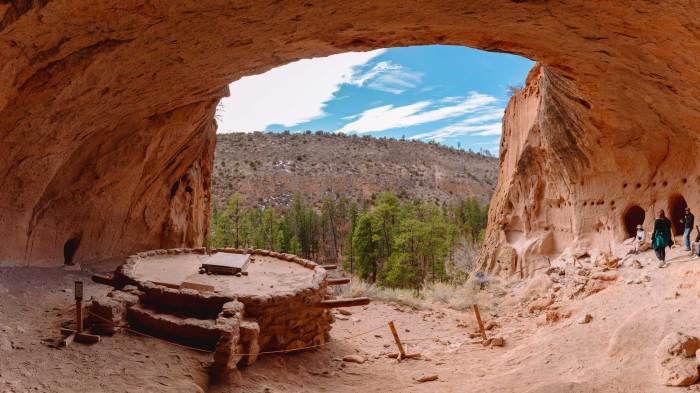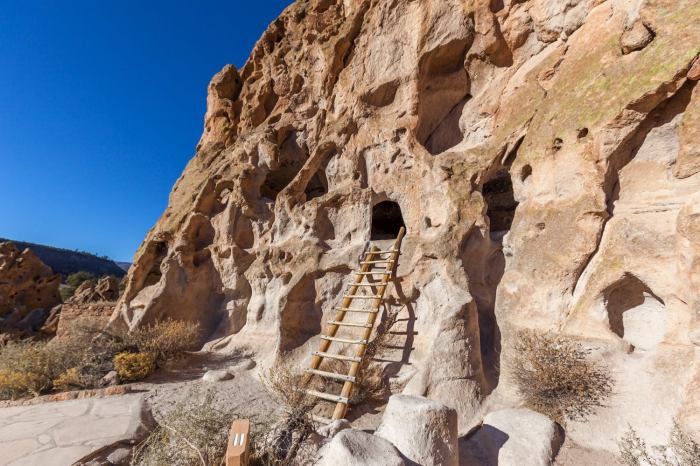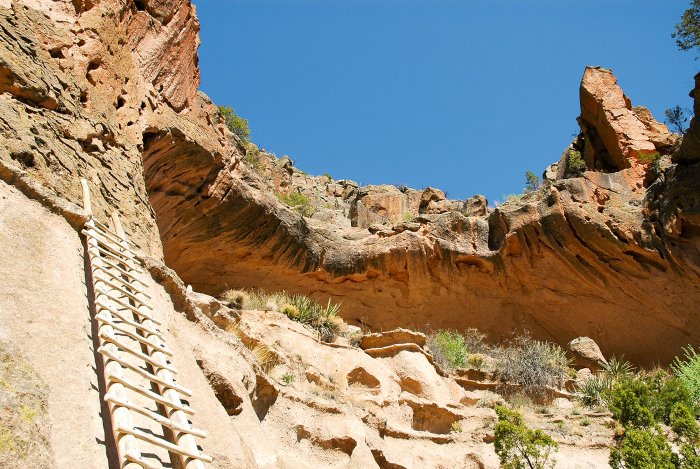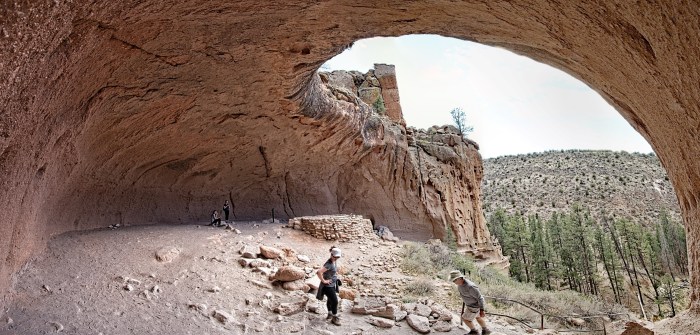Nestled amidst the breathtaking landscapes of New Mexico, Bandelier National Monument stands as a testament to the rich cultural heritage and stunning natural beauty of the American Southwest. From its ancient cliff dwellings to its diverse ecosystems, Bandelier offers a captivating glimpse into the past and present of this remarkable region.
Established in 1916, Bandelier National Monument encompasses over 33,000 acres of rugged canyons, mesas, and volcanic cliffs. It is home to a remarkable collection of archaeological sites, including over 700 cliff dwellings, petroglyphs, and other cultural artifacts. These remnants of the past provide a window into the lives of the Ancestral Puebloan people who inhabited this area for centuries.
Bandelier National Monument History

Bandelier National Monument, established in 1916, preserves a rich cultural heritage spanning over 11,000 years. The monument encompasses over 33,000 acres of rugged canyons, mesas, and volcanic landscapes, showcasing the diverse history of the region.
The earliest known inhabitants of the area were nomadic hunter-gatherers who arrived around 9,000 BCE. By the 13th century CE, the Puebloan people had established permanent settlements in the canyons, constructing elaborate cliff dwellings and farming the surrounding land.
Ancestral Puebloans
The Ancestral Puebloans, also known as the Anasazi, flourished in the area from the 13th to the 16th centuries CE. They were skilled architects and engineers, building multi-story cliff dwellings that showcased their advanced knowledge of construction and resource management.
Bandelier National Monument is a must-see for history buffs and outdoor enthusiasts alike. Its stunning cliffs and canyons are home to ancient petroglyphs and remnants of Native American settlements. While scuba diving may not be the first activity that comes to mind when planning a trip to Bandelier, there are plenty of nearby lakes and rivers that offer excellent diving opportunities.
Scuba diving locations can be found throughout the region, so you’re sure to find one that fits your skill level and interests. After a day of exploring the underwater world, you can return to Bandelier and enjoy the park’s many other attractions.
- Cliff Dwellings: The most iconic feature of Bandelier National Monument is the well-preserved cliff dwellings built by the Ancestral Puebloans. These structures, carved into the soft volcanic tuff, provided shelter and storage space for the community.
- Kiva Complexes: Kiva complexes were ceremonial and social spaces for the Ancestral Puebloans. These underground chambers, often circular in shape, were used for religious rituals, community gatherings, and storytelling.
- Petroglyphs and Pictographs: The Ancestral Puebloans left behind numerous petroglyphs and pictographs on the rocks throughout the monument. These images provide valuable insights into their beliefs, rituals, and daily life.
Spanish Colonization
In the 16th century, Spanish explorers arrived in the area, bringing with them new technologies and diseases. The Spanish established missions and settlements in the region, but their presence had a devastating impact on the Ancestral Puebloans.
- Disease: European diseases, such as smallpox and measles, decimated the Ancestral Puebloan population, causing many settlements to be abandoned.
- Missionization: The Spanish attempted to convert the Ancestral Puebloans to Christianity, establishing missions and forcing them to adopt Spanish customs.
- Forced Labor: The Spanish forced the Ancestral Puebloans to work in mines and on haciendas, leading to further population decline and cultural disruption.
Preservation and Protection
In the late 19th century, interest in the cultural and archaeological significance of Bandelier Canyon grew. In 1916, President Woodrow Wilson established Bandelier National Monument to protect the ruins and artifacts left behind by the Ancestral Puebloans.
- Archaeological Research: Bandelier National Monument has been the site of extensive archaeological research, uncovering new insights into the lives and culture of the Ancestral Puebloans.
- Cultural Preservation: The monument plays a vital role in preserving the cultural heritage of the region, protecting the cliff dwellings, petroglyphs, and other artifacts from vandalism and degradation.
- Educational Programs: Bandelier National Monument offers educational programs and guided tours, allowing visitors to learn about the history and culture of the area.
Geological Formations and Landscapes

Bandelier National Monument boasts a diverse array of geological formations and landscapes that have shaped its unique ecosystem and cultural history.
The monument is primarily composed of the Bandelier Tuff, a volcanic rock formed by a massive eruption approximately 1.2 million years ago. This tuff forms the steep canyon walls and mesas that characterize much of the monument’s terrain.
Volcanic Cliffs and Canyons
The Bandelier Tuff is highly resistant to erosion, resulting in the formation of sheer volcanic cliffs and deep canyons. The most prominent of these is the Rio Grande Gorge, a 800-foot deep canyon carved by the Rio Grande River. The gorge provides stunning views of the surrounding landscape and is a popular destination for hiking, rafting, and fishing.
Mesas and Plateaus
In addition to the canyons, the Bandelier Tuff also forms mesas and plateaus. Mesas are flat-topped mountains with steep sides, while plateaus are large, elevated areas of land. These formations provide important habitat for plants and animals and offer panoramic views of the surrounding landscape.
Impact on Ecosystem and Cultural History
The geological formations of Bandelier National Monument have had a profound impact on its ecosystem and cultural history. The steep cliffs and canyons have provided shelter and nesting sites for birds and other wildlife, while the mesas and plateaus have served as hunting grounds and gathering areas for Native Americans for centuries.
Archaeological Significance: Bandelier National Monument

Bandelier National Monument is renowned for its exceptional archaeological significance, showcasing the rich cultural heritage of the region’s past inhabitants. The monument encompasses numerous archaeological sites, including cliff dwellings, petroglyphs, and other artifacts, providing invaluable insights into the history and culture of the ancestral Puebloan people.
The cliff dwellings, carved into the sheer canyon walls, are particularly remarkable. These structures, some dating back over a thousand years, served as homes for the Puebloan people, offering protection from the elements and potential threats. The dwellings vary in size and complexity, reflecting the evolving architectural skills and societal organization of their builders.
Petroglyphs and Other Cultural Artifacts
Petroglyphs, intricate carvings etched into rock surfaces, are another significant archaeological feature within the monument. These petroglyphs depict a wide range of subjects, including animals, humans, geometric patterns, and symbolic representations. They offer a glimpse into the beliefs, rituals, and daily lives of the past inhabitants.
In addition to cliff dwellings and petroglyphs, Bandelier National Monument also contains numerous other cultural artifacts, such as pottery shards, stone tools, and agricultural terraces. These artifacts provide further evidence of the diverse activities and lifestyles of the ancestral Puebloan people.
The archaeological resources within Bandelier National Monument are of immense importance in understanding the history and culture of the region’s past inhabitants. Ongoing efforts are underway to preserve and protect these resources for future generations, ensuring that their legacy continues to inspire and inform.
Flora and Fauna

Bandelier National Monument is a haven for a diverse array of plant and animal species. Its unique geological formations and varied ecosystems support a rich tapestry of life, including over 700 species of plants, 450 species of birds, 80 species of mammals, 50 species of reptiles, and 15 species of amphibians.
Riparian Areas
Riparian areas along the Rio Grande and its tributaries provide vital habitats for a variety of plant and animal species. Cottonwood, willow, and ash trees create a lush canopy, providing shade and nesting sites for birds and other wildlife. The understory is home to a variety of shrubs, grasses, and wildflowers, which support a diverse community of insects, amphibians, and reptiles.
Grasslands
Grasslands cover much of the mesa tops and canyon slopes within the monument. These areas are dominated by blue grama, galleta grass, and other drought-tolerant species. Grasslands provide habitat for a variety of mammals, including pronghorn, elk, and mule deer. Birds such as hawks, owls, and songbirds also rely on grasslands for nesting and foraging.
Forests, Bandelier national monument
Forests are found in the canyons and on the mesa tops of Bandelier National Monument. Ponderosa pine, Douglas fir, and white fir are the dominant tree species in these forests. The understory is composed of a variety of shrubs, including mountain mahogany, serviceberry, and chokecherry. Forests provide habitat for a variety of animals, including black bears, mountain lions, and coyotes.
Biodiversity and Conservation
The biodiversity of Bandelier National Monument is essential for the health and functioning of the ecosystem. Each species plays a unique role in the food chain, nutrient cycling, and pollination. The monument’s staff is actively involved in conservation efforts to protect and preserve the diverse plant and animal species within its boundaries. These efforts include habitat restoration, wildlife monitoring, and invasive species control.
Recreational Opportunities

Bandelier National Monument offers a diverse range of recreational activities that allow visitors to explore its natural and cultural wonders. These activities include hiking, camping, wildlife viewing, and more.
The monument has a well-developed trail system that caters to hikers of all levels. The trails range from short, easy walks to challenging multi-day hikes. Some of the most popular trails include the Main Loop Trail, the Alcove House Trail, and the Falls Trail.
Camping
Bandelier National Monument offers several campgrounds for visitors who wish to stay overnight. The campgrounds are located in different areas of the monument, providing a range of options for visitors. The campgrounds offer a variety of amenities, including picnic tables, fire rings, and restrooms.
Bandelier National Monument offers a glimpse into the past with its well-preserved cliff dwellings, providing a unique opportunity to explore the ancient culture of the Puebloan people. While their way of life differs significantly from that of the nomadic Bedouin , both groups shared a deep connection to the land and a rich cultural heritage.
Bandelier’s rugged landscapes, dotted with ancient ruins, invite visitors to immerse themselves in the fascinating history of this region.
Wildlife Viewing
Bandelier National Monument is home to a variety of wildlife, including deer, elk, turkeys, and birds. Visitors can often see wildlife along the trails or in the campgrounds. The monument is also home to a number of endangered species, such as the Mexican spotted owl and the Rio Grande silvery minnow.
Bandelier National Monument is a historical site located in the Jemez Mountains of New Mexico. The park is home to the remains of the ancient Puebloan people, who lived in the area from around 1150 to 1550 AD. The monument is also home to a variety of wildlife, including deer, elk, and bear.
If you’re looking for the best places to visit in the USA , then Bandelier National Monument should definitely be on your list.
Responsible Recreation
It is important to practice responsible recreation when visiting Bandelier National Monument. This includes staying on designated trails, packing out all trash, and respecting the natural and cultural resources of the monument. Visitors should also be aware of the potential for wildlife encounters and take appropriate precautions.
The Leave No Trace principles are a set of guidelines that help visitors minimize their impact on the environment. These principles include:
- Plan ahead and prepare.
- Travel and camp on durable surfaces.
- Dispose of waste properly.
- Leave what you find.
- Minimize campfire impacts.
- Respect wildlife.
By following these principles, visitors can help to protect the natural and cultural resources of Bandelier National Monument for future generations.
Concluding Remarks

Bandelier National Monument is a place where history, nature, and culture intertwine. Its unique geological formations, diverse ecosystems, and rich archaeological heritage make it a must-visit destination for anyone seeking adventure, knowledge, and inspiration.
FAQ Compilation
How do I get to Bandelier National Monument?
The monument is located about 40 miles northwest of Santa Fe, New Mexico. You can reach it by taking Highway 502 north from Santa Fe or Highway 4 from Los Alamos.
What are the best hiking trails in Bandelier National Monument?
There are several excellent hiking trails in Bandelier National Monument, including the Main Loop Trail, the Alcove House Trail, and the Falls Trail. These trails offer varying levels of difficulty and provide access to some of the most iconic sites in the monument.
Can I camp in Bandelier National Monument?
Yes, there are two campgrounds in Bandelier National Monument: the Juniper Campground and the Cottonwood Campground. Both campgrounds offer a variety of campsites, from primitive tent sites to RV hookups.